A JUNGLE MARCHED THRU BED-STUY (1900)
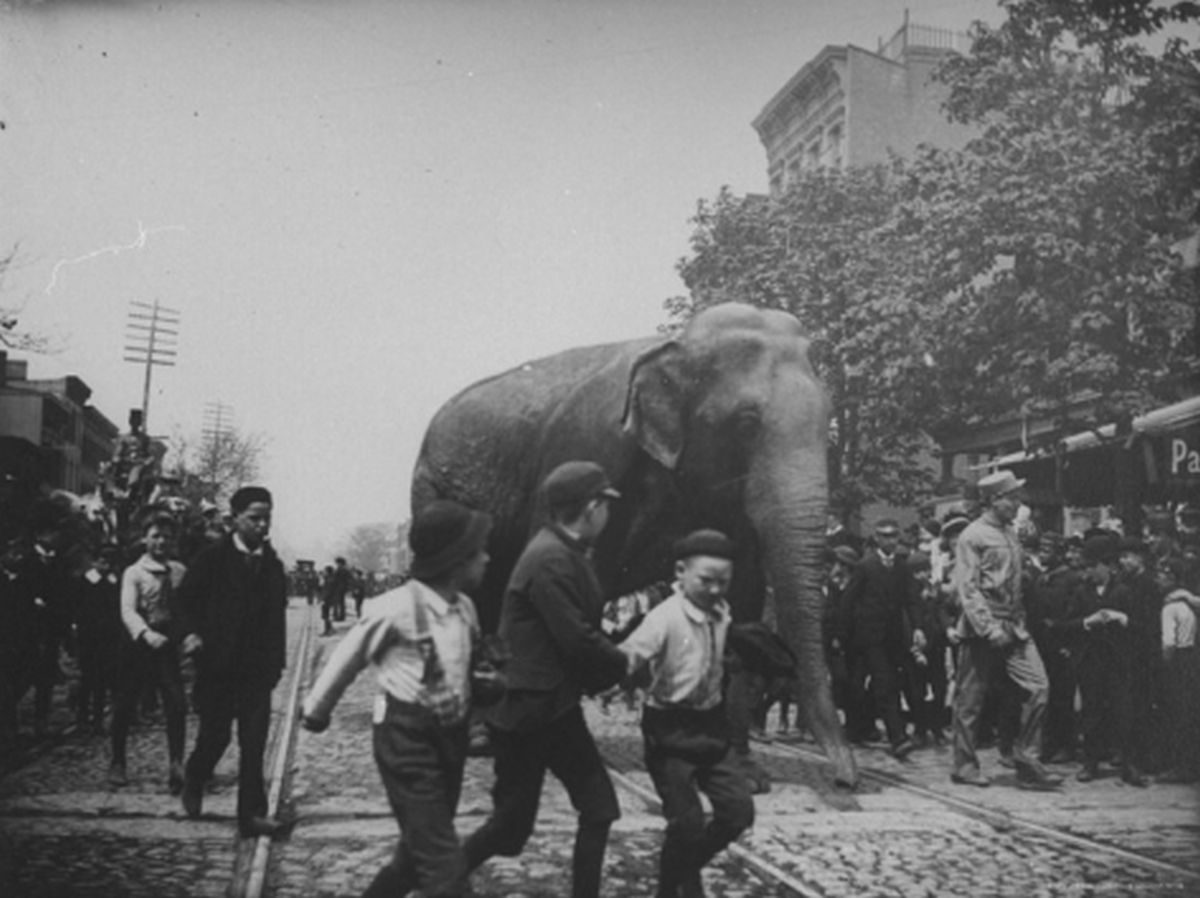
Brownstone Detectives investigates the history of our clients’ homes.
The story you are about to read was composed from research conducted in the course of one of those investigations.
Do you know the history of YOUR house?
********************************************************************************************************************************
The grey mastodons pounded threateningly down Howard Avenue past the gloomy darkness of Saratoga Square Park. Lumbering slowly around the corner onto Macon Street, they let forth a great trumpeting roar, swaying rhythmically to and fro. As their long, great shadows danced menacingly on the canopy of the park’s trees, cast vaguely by the faint light of the omnipresent red and green flickering colored torches, they presented a terrifying and foreign spectacle.
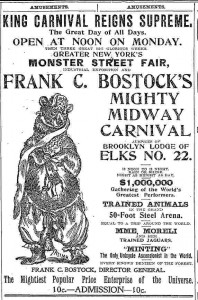
Hundreds of small boys darted in and out of the gathering throngs to view the intimidating beasts, instilling in the air a noticeably heightened excitement which spread further and further down the block, as the presence of these creatures became known.
As these majestic monsters moved towards 738 Macon Street, they let out their crushing roar which now could be felt more by the bones than by the ears. A great moan of excited joy leapt, in a synchronized response, from the lips of the visually excited crowd as each and every person lining the Macon Street parade route viewed the very first elephants.
As the grey forms, dabbled in red and green light, diminished in size on their trek towards Ralph Avenue, they were replaced by the great humpbacked dromedaries with their inartful steps and studied looks of half-disdain. Purposefully chewing their cuds in a back and forth motion, and from time to time spitting their disapproval at the gathered crowds, they trod down the asphalt street complaining often and to no one in particular.
The throngs spilled over from the sidewalk flagging, partly on the street edges and partly into the front yards of the brownstones. Family members filled their front stoops and hung down from nearly every window, while many of the young men laid down upon the edges of the rooflines of the row houses to view the spectacle from the highest perches. Every imaginable noise and odor filled the air, as Macon Street took on a distinctly international and carnivalesque atmosphere.
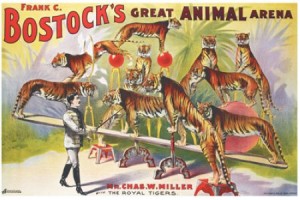
At some point, the sea of exotic creatures and peoples began to arrive at a breakneck speed (at least that is how it would seem the next day!), as around the corner onto Macon Street came a cornucopia of trained horses, zebras, quaggas, and water buffalos, each with their handlers, many with riders. The sacred monkeys cackled with an unrestrained glee; Fatima the Dancing Bear stood upright on her hinds, thrilling the crowds; Madame Morelli’s Trained Jaguars restively paced to and fro within the confines of their caged vans; ostriches darted about, displaying worried looks; Prof. Bristol’s equine Paradox (“the smallest horse in the world”!) attached to a miniature carriage, pranced forward with mincing steps; Chinese jinrickshaws filled with “lounging Orientals” were drawn by coolies; Gen. Cronje’s trek wagon rolled by, complete with Boers; Chief Carlo, of the Wild West Shows, appeared in a stage coach from Broken Bend, along with hordes of Mexicans, Turks, Dervishes, Indians, cowboys, scouts, squaws and papooses, 300 armored horsemen, bands of musicians interspersed throughout the various participants, English soldiers, people of all nations, Mygrant’s Band in the bandwagon pulled by six snow white horses, and “a troupe of 100 gayly-attired Mardi Gras fun-makers,” mounted and on foot.
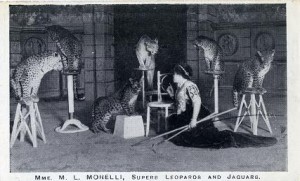
The animal procession, mostly provided by Frank Bostock’s Mighty Midway Carnival, was the third of three divisions in the order of parade. The first division was filled with troops of all kinds, politicians, notables, and drum and fife corps’, while the second division comprised of fraternal organizations, including the Elks, who were sponsoring the event.
The entire procession had begun from the large open lot at the corner of Halsey and Broadway (now a Rite Aide) at 8 p.m., on a fair 51-degree Saturday evening. It started with the “$50,000” Venetian gondolas, carrying the “beautiful daughters of the Orient.” This entrance was the first, and possibly the last, time that such ornamental – and expensive – Italian vessels would “float” the wrong way down Macon Street.
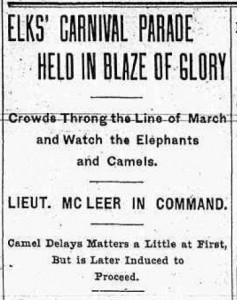
From the top of the stoop at 738 Macon Street, the members of the Corlett Family had box-seats to view the entire drama of the parade unfold.
The inaugural parade, sponsored by the Benevolent and Protective Order of the Elks, Lodge No. 22, was to kick off the 3-week carnival, and would march for miles through Brooklyn streets to celebrate the Elks’ 17th anniversary.
Close to the center of the parade, holding positions of importance, were those figures of fraternal nobility. Knights of Pythias, Knights of Malta, and the hosts of the entire event, the Order of Elks, rode on horseback, in carriages, and on foot.
Adolph E. Muller, a well-known realtor and an Elk in good standing, was a proud member of this organization. He was one of many Elks in the parade waving to the crowds and smiling at the cheering faces along the route.
As Adolph’s carriage moved past, he could not have failed to note the ever-present wide-eyed faces of the excited boys, as his mind must have raced back to a day, 30 years earlier, when he, as a small boy of six, would have thrilled at just such a spectacle.
When Adolph’s carriage turned from Howard Avenue onto Macon Street, it is a distinct possibility that his eyes lit upon the towering row of six 3-story houses sitting square within the middle of the smaller rowhouses on the block.
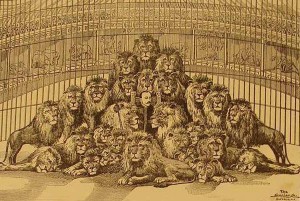
As his eyes came to rest on 738 Macon Street, he purveyed the figures on the roof, glancing down the rough-stone façade of the building, his gaze bringing into focus the stoop below.
At this point, it is quite possible that he would have come, literally, face-to-face with the current owner, Robert H. Corlett, and his wife, Mary, their two girls and one boy. Adolph may have even possibly thought, “What a wonderful house for such a family.”
As his carriage moved further down Macon Street and out of sight, Robert Corlett’s mind was too busy with the profusion of sights and sounds to think about the recent deaths in his family, and how, he had been talking with his wife recently about selling the house and moving the family for a fresh start.
Just one year later, in May of 1901, the Corletts would be loading the moving vans to move out of No. 738 Macon Street; Adolph Muller and his family would be loading their moving vans – to move in.
———————————————————————————————————————–
 Brownstone Detectives is an historic property research agency. Our mission is to document and save the histories of our clients’ homes. From our research, we produce our celebrated House History Books and House History Reports. Contact us today to begin discovering the history of your home.
Brownstone Detectives is an historic property research agency. Our mission is to document and save the histories of our clients’ homes. From our research, we produce our celebrated House History Books and House History Reports. Contact us today to begin discovering the history of your home.